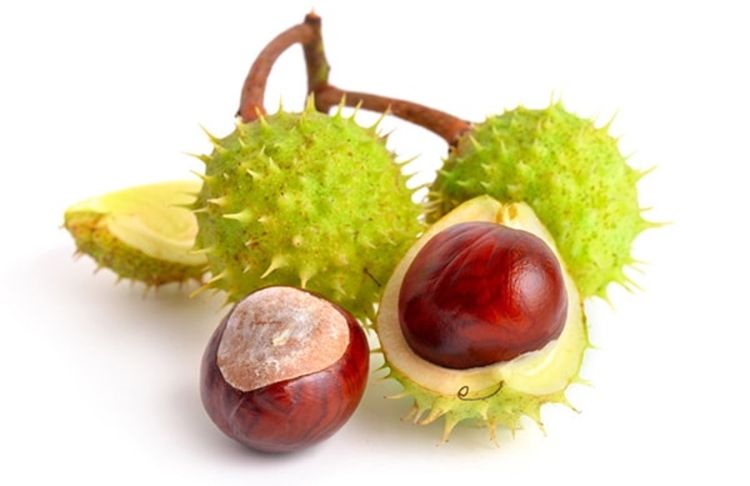BACKGROUND
Ingredient Type: Botanical, Extract
Also Known As: Aesculus hippocastanum, Buckeye, Common horse chestnut, European horse chestnut

Horse chestnut seed extract (HCSE), comes from a tree that is commonly known as buckeye. The tree is indigenous to the mountains of Greece, Bulgaria, the Caucasus, northern Iran, and the Himalayas, but is now cultured internationally, particularly in Europe and Russia. The buckeye fruit has a thick husk and contains from one to six seeds. These seeds, known as the horse chestnuts, have been used medicinally for centuries. It is believed that traditional healers from Indian roasted, peeled, and mashed chestnut seeds and then leached them in lime to render them less toxic. In European folk medicine, carrying the fruit in a pocket was believed to prevent or cure arthritis.
Horse chestnut seed extract is widely used in Europe today for chronic venous insufficiency (CVI), a syndrome characterized by lower extremity edema, varicosities (1), pain, pruritus, atrophic skin changes, and ulcerations (3).
TRADITIONAL USES
Orally, horse chestnut seed and leaf have been used for the treatment of varicose veins, hemorrhoids, and phlebitis. Standardized horse chestnut seed extract products are used orally for the treatment of chronic venous insufficiency.
WHAT DOES SCIENCE TELL US?
There is strong supportive scientific evidence for its role in chronic venous insufficiency (2,4,5,6).
SAFETY
Horse chestnut seed is likely safe when used orally and appropriately, short-term. Standardized horse chestnut seed extracts seem to be safe when used for 2-12 weeks (7,8). These extracts have removed the primary toxic constituent, esculin (9).
Interactions:
Moderate
- Anticoagulant/antiplatelet drugs, Antidiabetic drugs, Lithium
Theoretical
- Because horse chestnut seed may potentiate antiplatelet effects it hypothetically may interact with other natural supplements that have a similar effect: Angelica, Clove, Danshen, Garlic, Ginger, Ginkgo, Panax ginseng, Red clover and others.
- It hypothetically may also interact with other supplements that have hypoglycemic additive effects: Alpha lipoic acid, Chromium, Devil’s claw, Fenugreek, Garlic, Guar gum, Panax ginseng, Psyllium, Siberian ginseng, and others.
Pharmacokinetics:
The half-life of horse chestnut is approximately 10-20 hours. Peak plasma levels occur 2-3 hours after ingestion. The bioavailability of beta-aescin, the main active constituent of horse chestnut seed extract, was evaluated in two randomized crossover clinical trials involving 18 healthy volunteers each (12). Daytime absorption is slightly better than nighttime.
REFERENCES
- Dattner, A. M. From medical herbalism to phytotherapy in dermatology: back to the future. Dermatol.Ther 2003;16(2):106-113.
- Bielanski, T. E. and Piotrowski, Z. H. Horse-chestnut seed extract for chronic venous insufficiency. J Fam Pract 1999;48(3):171-172.
- Siebert, U., Brach, M., Sroczynski, G., and Berla, K. Efficacy, routine effectiveness, and safety of horsechestnut seed extract in the treatment of chronic venous insufficiency. A meta-analysis of randomized controlled trials and large observational studies. Int Angiol. 2002;21(4):305-315.
- Ehringer, H. [On the vein tonicising principle of horse chestnut extract. Effect of pure horse chestnut extract and aescin on the venous capacity, venous tonus and circulation of the extremities]. Med Welt. 8-24-1968;33:1781-1785.
- Ernst, E., Pittler, M. H., and Stevinson, C. Complementary/alternative medicine in dermatology: evidence-assessed efficacy of two diseases and two treatments. Am J Clin Dermatol. 2002;3(5):341-348
- Pittler, M. H. and Ernst, E. Horse chestnut seed extract for chronic venous insufficiency. Cochrane.Database.Syst.Rev. 2012;11:CD0032307. 281
- Pittler MH, Ernst E. Horse chestnut seed extract for chronic venous insufficiency (Cochrane Review). In: The Cochrane Library, Issue 3, 2004. Chichester, UK: John Wiley & Sons, Ltd. .
- Anon. Horse Chestnut. The Natural Pharmacist 2000. www.tnp.com/substance.asp?ID=62. (Accessed 24 June 2000).
- Kreysel, H. W., Nissen, H. P., and Enghofer, E. A possible role of lysosomal enzymes in the pathogenesis of varicosis and the reduction in their serum activity by Venostasin. Vasa 1983;12(4):377-382.
- Guillaume, M. and Padioleau, F. Veinotonic effect, vascular protection, antiinflammatory and free radical scavenging properties of horse chestnut extract. Arzneimittelforschung 1994;44(1):25-35
- Carrasco, O. F., Ranero, A., Hong, E., and Vidrio, H. Endothelial function impairment in chronic venous insufficiency: effect of some cardiovascular protectant agents. Angiology 12-20-2009;60(6):763-771
- Bassler, D., Okpanyi, S., Schrodter, A., Loew, D., Schurer, M., and Schulz, H. U. Bioavailability of beta-aescin from horse chestnut seed extract: comparative clinical studies of two Galenic formulations. Adv.Ther. 2003;20(5):295-304
See the National Center for Complementary and Integrative Health entry for horse chestnut, the RXList entry for horse chestnut, the Examine.com entry for horse chestnut, this European Medicines Agency monograph on Aesculus hippocastanum, the Michigan Medicine Health Library entry for horse chestnut, or the WebMD entry for horse chestnut for more information.









